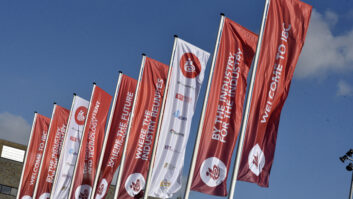
The market for pro-AV-driven broadcasting seems to be growing rapidly across a number of sectors – with the applications within training and education being most commonly cited. What is it, though, that’s enabling this market growth?
“There’s a greater breadth of affordable, multi-functional, easy-to-operate production tools that allow users with minimal production experience to deliver impactful content to both the external network and internally via traditional displays or more dynamic content collaboration solutions such as Vision Presenter,” according to Olivier Bovis, head of AV media marketing at Sony Europe. “Affordable, compact cameras, such as Sony’s X70, mean that capturing high-quality footage is an accessible option, and the range of accessories and software upgrades mean that a company’s investment will be future-proofed. All-in-one production units, like Sony’s portable live content producer Anycast Touch, and cloud-based media platforms, ensure that workflow is easier to manage than ever before on a smaller scale.”
For Riedel’s product manager Christian Diehl, it’s all about the network.
“New standards for network transport technologies such as AES67, AVB and SMPTE-2022 are the big drivers,” he says. “Then, there are products like Riedel’s MediorNet real-time signal distribution network, with which we serve customers from the broadcast as well as the AV/installation market.”
“Encoders like Mediasite are creating the opportunity to transform traditional audiovisual environments into real-time studios,” claims Sean Brown, senior VP at Sonic Foundry. “Enterprise video systems, such as our end-to-end system, create a workflow where a traditional stand-and-deliver presentation from existing rooms becomes a live broadcast session via the web to any device within reach of the internet.”
“The main drivers behind the adoption of video for communication have been the increased quality and availability of bandwidth, recording facilities and the improvement of digital asset management systems,” adds Tripleplay’s James Keen. “These factors make delivery, production and management much simpler, more efficient and more achievable for any business.”
For sure, many commentators fear a future where production values are eroded as broadcasting becomes democratised. Sony’s Bovis is, however, hopeful.
“In-house content production and bespoke internal broadcast will only become more widespread as audiences are used to personalised content and businesses are aware of this, meaning investment will increase,” he says. “Ultimately, adoption will increase as the capabilities of the technology rise, prices fall, and internal teams upskill to produce content. This means that the quality of content produced which can be broadcast internally and distributed across their networks will also improve.”
As with any engagement, it’s vital that the customer, rather than the integrator, sets the required standard – with the integrator guiding the customer as to the implications of various choices. Budget, of course, is among those implications – a point made by Tim Brooksbank, chairman of Calibre, who sees frame rate conversion challenges for organisations looking to broadcast to, or include material from, multiple countries.
“High-quality MEMC [Motion Estimation/Motion Compilation] broadcast frame rate converters such as Snell Alchemist and For-A FRC-8000 are excellent but outside the budget of most users in the crossover market,” he says. “Calibre’s MEMC Fovea-F1 frame rate converter provides comparable image quality at a fraction of the cost through its highly efficient implementation which permits a lower cost of technology. Without products like Fovea-F1, the crossover market has to make do with software-based frame rate conversion, or linear converters, neither of which produce good results on fast-moving complex content.”
There is plenty of other value that integrators can bring – and challenges they may face.
“Much of the knowledge needed in in-house broadcasting is very similar to that needed in other AV applications,” says Keen, “from the hanging of screens to the network configuration – although there is some specialist software used that may be a little out of the ordinary. This includes digital asset management solutions and video streaming portals that traditional AV integrators may not be familiar with, but with a good broad AV knowledge it wouldn’t be too much for them to extend their portfolio and knowledge base to support such deployments.”
www.sony-europe.com
www.calibreuk.com
www.riedel.net
www.sonicfoundry.com
www.tripleplay-services.com






